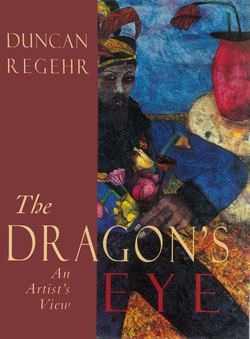Читать книгу Dragon's Eye - Duncan Regehr - Страница 9
На сайте Литреса книга снята с продажи.
ОглавлениеPROLOGUE
the story of
the title
I WAS FILMING IN TORONTO during the Chinese New Year of 1988 (the Year of the Dragon). On a day off work I stopped by a small art supply shop in Chinatown and asked the proprietor where I could have a “chop” made. A chop is an engraved seal or ink-crest used mainly in the Orient as a signature by artists, officials and merchants to indicate the authenticity of drawings, goods, and manuscripts.
From the back room came a muffled voice. “I make. What you want for?”
The proprietor waved me through a curtained opening behind the counter. A small, elderly Chinese gentleman sat at a low desk lined with carving tools and various bits of soapstone.
“I’m an artist,” I said, gesturing to the portfolio under my arm. “I was hoping to find someone who could make me a chop so that I can seal my work with it.”
“I am also artist. Show me,” he said, indicating my portfolio.
I spread my work out on a side counter. Most of the pieces were pen and ink line drawings, with a few black and white lithographs.
He took his time, studying the lines and details of each piece, at one point pausing to write my initials on a pad beside him. Finally, he held up a lithograph of “Brother Dragon and His Companion.”
“You see through eye of the dragon,” he smiled. “You give me this, I will make chop for you.”
“O.K.” I agreed. “But we should decide on a design.”
Brother Dragon and His Companion PEN AND INK 18”x24”
He opened a drawer and pulled out a news article from the Toronto Star about the Year of the Dragon and a symbol that was believed to be the oldest written sign (well over ten thousand years old) of a Chinese dragon.
He carefully copied the dragon image, drawing beside it the initials of my name:
“You go now, come back maybe two hours. I make good chop for you. Dragon’s eye.” He chuckled.
A few hours later, I was embossing “Brother Dragon and His Companion” with my new chop. The old fellow had cleverly combined and carved the three images into a circular shape, not unlike an eye.
I have used the “Dragon’s Eye” ever since, applying it to drawings, oil paintings, watercolors, and also to pieces that predate my chop’s creation. I remained puzzled by the old man’s comment, “You see through eye of the dragon,” until the New Year of 1993 (the Year of the Rooster).
While I was writing this book and looking for an appropriate title, I became aware of an ancient Zen parable.
A master artist was summoned to the Emperor’s court to paint an enormous mural of a dragon. He sent word that he was involved with other work of great importance and that he would be unable to do the painting.
A royal aide arrived on the artist’s doorstep with imperial orders to begin the mural at once. Again the artist explained that he was too involved with other work.
The royal guards then seized the artist and dragged him to the Emperor’s palace, where he was told that if he did not start painting immediately he would be put to death.
The artist did as he was told. In a single day, he painted a most glorious multi-colored dragon, limned in gold.
That evening the royal aide came to look upon the finished work and proclaimed it a masterpiece. The artist was paid a commission and told that the Emperor and his court would view the painting in the morning.
The artist waited until everyone in the palace had gone to bed before applying two glowing white dots to the deep centers of the dragon’s eyes. After collecting his materials, he covered the mural with a veil. Then he disappeared into the night and the far-off forest.
Early the next day, the mural was unveiled before the Emperor and his court. All were enchanted by its exquisite beauty and lifelike features. As words of praise were voiced, the dragon’s eyes flickered. His body slowly turned and he rose into the air, circling above the court before flying out of a window, leaving only his intricate outline on the white palace wall, and the red chop of the artist.
